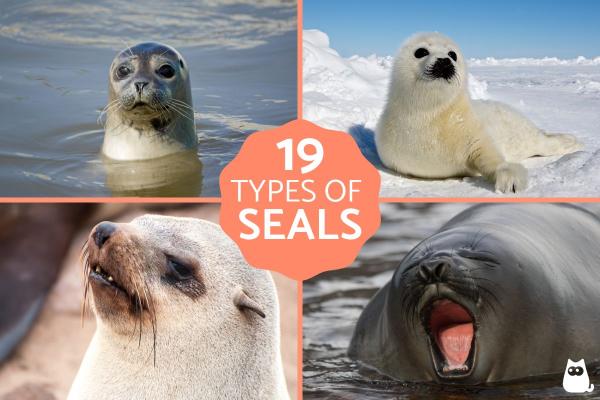
Seals are marine mammals found in all oceans around the world, and even in some freshwater areas. As members of the Phocidae family, seals are known for their thick blubber, flipper-like limbs, and powerful swimming skills. There are many different types of seals, each with its own traits, habitats, and behaviors. While they may look similar to walruses or sea lions, true seals don’t have tusks and belong to a different animal group.
In this article by thedailyECO, you'll discover all the true seal species with photos, fun facts, and tips to tell them apart.
Classification of seals
The Phocidae family, which includes all seal species, is divided into two subfamilies with species that share anatomical, ecological, and behavioral characteristics but differ in their geographical distribution. As mentioned, seals are found in virtually all oceans worldwide and have developed various adaptations for marine life throughout their evolution.
Northern Hemisphere seals are generally somewhat larger than their Southern Hemisphere relatives.
Also, of the 19 existing seal species, two are freshwater seals, while the rest are marine species, with three of them inhabiting warmer waters rather than icy regions.
Seals are classified into two subfamilies based on their location:
- Phocinae subfamily: includes Northern Hemisphere seals.
- Monachinae subfamily: includes Southern Hemisphere species and some species of the Monachus genus (monk seals).
Let's explore some examples from each subfamily in more detail.
Seal species in the Phocinae subfamily
The Phocinae subfamily comprises a total of 10 types of seals. Here are four notable species:
Bearded Seal (Erignathus barbatus):
This species inhabits the Arctic Ocean and is medium-sized, measuring about 2.2 meters (7.2 feet) but can reach nearly 3 meters (9.8 feet), with males and females being similar in size.
The most distinctive characteristic of this seal species is the position of its front limbs, which are located frontally, unlike other seal species. Additionally, it has an abundant whisker set, which gives it its name. Its body is brownish in color, becoming more reddish around the head and neck. Another aspect that differentiates this species is the presence of two nipples.
Bearded seals feed on a variety of fish, clams, and squid, which they hunt by diving. The bearded seal is the favorite prey of polar bears and has also been hunted for centuries by the Inuit people of Arctic regions.
Hooded Seal (Cystophora cristata):
Also known as the bladder-nosed seal, this species is found in the North Atlantic Ocean and the Arctic. Undoubtedly, the most characteristic feature of this seal is the male's enlarged nasal cavities, which gave it the name "hooded seal," as it appears to have a hood on its head when the adult male inflates it with air.
Males reach around 3 meters (9.8 feet) in length, while females grow to about 2 meters (6.6 feet), demonstrating sexual dimorphism. Their coloration is dark, with brown or black tones and a mottled back. This species is not gregarious and only forms large groups during the mating season.
Hooded seals are common in open sea areas, always on oceanic ice from where they dive about 100 meters (328 feet) in search of food, which varies between a great diversity of fish and cephalopods.
Harbor Seal or Common Seal (Phoca vitulina):
This is the most widely distributed type of seal, found along coastlines throughout the northern Atlantic and Pacific Oceans, the North Sea, and the Baltic Sea. It is medium-sized, with males reaching almost 2 meters (6.6 feet) in length. Females are somewhat smaller.
These seals are gray or cinnamon-brown in color with a pattern of spots that varies with each individual, which characterizes this species. Additionally, their nostrils are curved in a V-shape. The harbor seal is gregarious and always stays with family members on rocky sites where they rest and which are also well-stocked with food, showing great fidelity to these locations.
They possess mechanoreceptors that allow them to identify objects moving underwater, offering perfect orientation when hunting.
Ribbon Seal (Histriophoca fasciata):
This species is found in the Arctic regions of the Pacific Ocean, the Bering Sea, and the Sea of Okhotsk. It is the least known seal species due to its remote habitats and the fact that it spends much time in the water.
Its common name derives from the ribbon-like design covering its body, as adults have very distinctive markings consisting of a dark background with a set of light bands that surround the head, the rear of the body, and the front flippers.
This species lives exclusively on oceanic ice and, during the breeding or molting season, seeks icy platforms for these processes. It has an air sac connected to the trachea, which provides buoyancy when inflated, often used to float and rest on the water. Like other species, the ribbon seal feeds on squid, shrimp, and various fish.
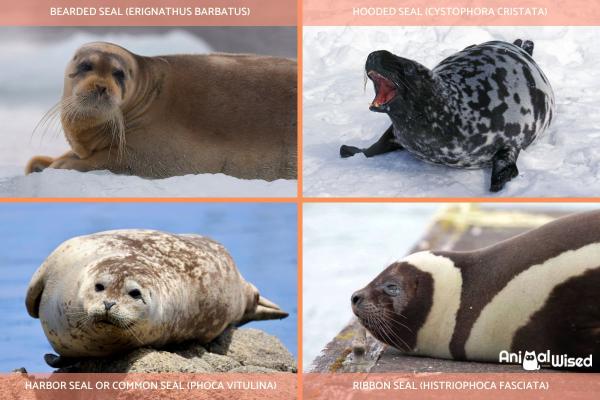
Harp Seal (Pagophilus groenlandica):
The harp seal inhabits the northernmost Atlantic Ocean and parts of the Arctic Ocean. Adults are known for their distinctive appearance with a light gray body and a black face and a horseshoe-shaped black patch on their back (which gives them their name). Males and females are similar in size, reaching about 1.7-2 meters (5.6-6.6 feet) in length.
These seals are highly migratory and travel in large groups. They feed primarily on small fish and crustaceans. Harp seals are famous for their white-coated pups, which are born on pack ice. The breeding colonies can be enormous, with thousands of individuals gathered on the ice.
Ringed Seal (Pusa hispida):
The ringed seal is one of the smallest seal species, but has the widest distribution of any Arctic seal. It gets its name from the light-colored rings scattered on its dark gray coat. Adults typically measure 1.3-1.5 meters (4.3-4.9 feet) in length.
This seal is uniquely adapted to life under Arctic ice, maintaining breathing holes in the ice by using the strong claws on its front flippers. Ringed seals are solitary for most of the year and are capable of diving to depths of up to 300 meters (984 feet).
They build snow lairs on the ice for protection from predators and extreme cold, especially when rearing pups. Their main predators include polar bears, which often hunt them by breaking through these snow lairs.
Baikal Seal (Pusa sibirica):
The Baikal seal is one of only two exclusively freshwater seal species in the world. Endemic to Lake Baikal in Siberia, Russia, this seal has adapted to the unique environment of the world's deepest and oldest lake. Adults are relatively small, reaching 1.1-1.4 meters (3.6-4.6 feet) in length.
Their body is uniformly gray, and they have excellent underwater vision adapted for hunting in the clear waters of Lake Baikal. These seals can dive to impressive depths of up to 400 meters (1,312 feet) and can remain submerged for up to 40 minutes. During winter, they maintain breathing holes in the ice, similar to ringed seals.
Gray Seal (Halichoerus grypus):
The gray seal is distinguished by its elongated snout and horse-like head profile, which gave rise to its scientific name Halichoerus (meaning "sea pig"). Found across the North Atlantic, from North America to Western Europe, these seals exhibit significant sexual dimorphism. Males can reach up to 3 meters (9.8 feet) and weigh up to 400 kg (880 lbs), while females are considerably smaller.
Their coloration varies widely between individuals, but they typically have a gray coat with darker spots. Gray seals are excellent divers, reaching depths of up to 300 meters (984 feet), and feed primarily on a variety of fish species.
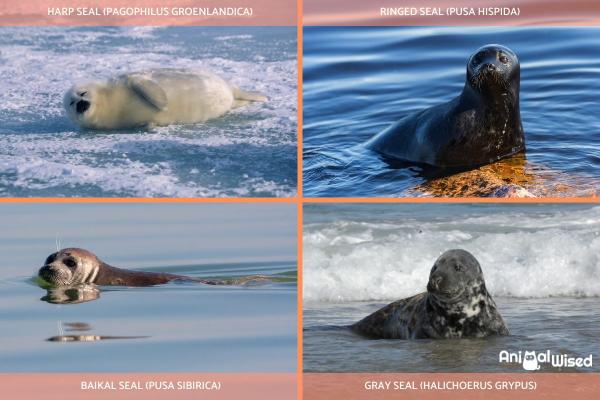
Spotted Seal (Phoca largha):
Found in the North Pacific Ocean, particularly around the Bering Sea, Sea of Okhotsk, and the Sea of Japan, these seals get their name from the distinctive spots covering their coat.
Adults reach about 1.5-1.7 meters (4.9-5.6 feet) in length. Spotted seals are well adapted to life on pack ice, where they breed and give birth. Unlike many Arctic seals, they are not typically found in areas of thick, stable ice but prefer the dynamic ice edge. They feed on a variety of fish and invertebrates and are known for their ability to make seasonal migrations following the advance and retreat of sea ice.
Caspian Seal (Pusa caspica):
As the name suggests, this seal is endemic to the Caspian Sea, the world's largest inland body of water, making it the other exclusively inland seal species besides the Baikal seal. The Caspian seal is one of the smallest seal species, with adults reaching only about 1.4 meters (4.6 feet) in length.
Their coat ranges from dark gray to yellowish-gray with irregular dark spots. They feed primarily on fish, particularly kilka (a type of sprat), and breed on ice floes in the northern Caspian Sea during winter months.
After learning about seal species, enhance your knowledge with our exploration of seal feeding behaviors and nutritional preferences.
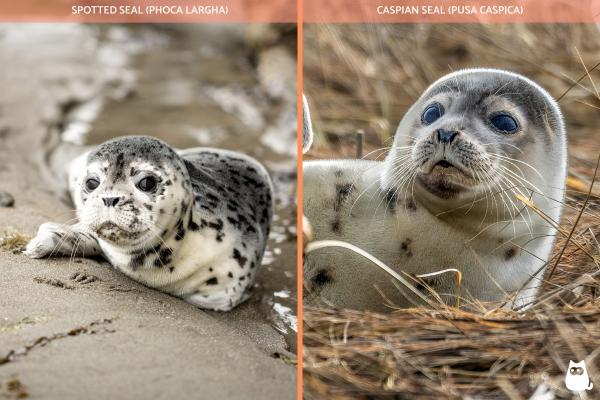
Seal species in the Monachinae subfamily
The Monachinae subfamily, often called "southern seals," comprises nine species organized into three tribes. While they primarily inhabit the Southern Hemisphere today, fossil evidence shows they were once common in the North Atlantic. Let's explore each species by tribe:
1. Tribe Monachini (Monk Seals):
Monk seals represent the most tropical members of the Monachinae subfamily, inhabiting warmer waters than their Antarctic relatives. They are characterized by their relatively slender bodies, proportionally large eyes, and lack of sexual dimorphism compared to other seal species. There are three species in this tribe:
Mediterranean Monk Seal (Monachus monachus):
The monk seal is distributed in the Mediterranean Sea and the North Atlantic Ocean, reaching the coasts of North Africa, although its distribution is increasingly limited, making it a very rare species to spot. It inhabits coastal areas and beaches sheltered by cliffs with caves that have entrances to the sea, where they generally reproduce.
Its current populations are very small, as it is a species that is critically endangered due to habitat loss caused by humans, overfishing, diseases caused by red tides produced by algae, among other causes.
Hawaiian Monk Seal (Neomonachus schauinslandi):
The Hawaiian monk seal is endemic to the Hawaiian archipelago and is one of the most endangered seal species in the world. Adults reach lengths of about 2.1-2.4 meters (7-8 feet) and have a silvery-gray coat that can appear brownish when dry. They have a relatively slender body compared to other seals.
These seals spend most of their time in the water but come ashore to rest, molt, and give birth. They feed primarily on reef fish, squid, octopus, and crustaceans, diving to depths of up to 300 meters (984 feet).
Caribbean Monk Seal (Neomonachus tropicalis):
The Caribbean monk seal, formerly found in the Caribbean Sea and Gulf of Mexico, was declared extinct in 2008. The last confirmed sighting was in 1952. This medium-sized seal had a brownish coat and reached lengths of about 2.1-2.4 meters (7-8 feet).
Historical accounts describe these seals as having been gentle and non-aggressive, making them easy targets for hunters who valued their oil and meat. Their extinction was primarily caused by extensive hunting in the 18th and 19th centuries, combined with habitat loss as human populations expanded throughout their range.
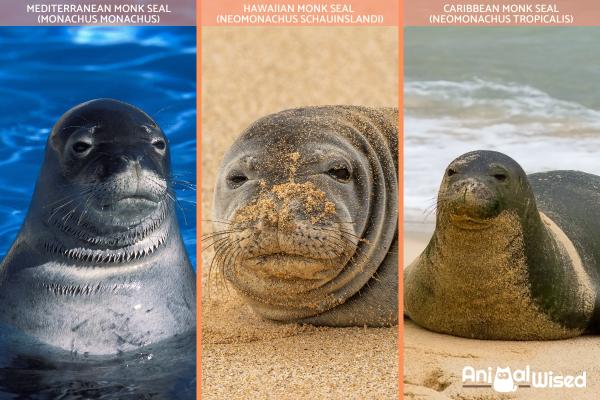
2. Tribe Miroungini (Elephant Seals)
Characterized by their enormous size and extreme sexual dimorphism. Males are significantly larger than females and possess a distinctive proboscis (elongated nose) that gives them their name. This tribe is remarkable for their extraordinary diving abilities, reaching some of the deepest depths of any air-breathing vertebrates. There are only two species in this tribe:
Northern Elephant Seal (Mirounga angustirostris):
This species is distributed throughout the Eastern Pacific Ocean, from Alaska to Baja California, where it inhabits oceanic islands.
Its main characteristic is the large proboscis that males have, which is used for roaring, especially during the reproductive season when they compete. This is a large species, where males can measure more than five meters (16.4 feet) in length and females about three meters (9.8 feet), so its sexual dimorphism is very marked. This is also associated with its reproductive mode, where males can mate with dozens of females during the mating season.
They are nocturnal hunters and can dive to more than 800 meters (2,625 feet) to search for food, which is based on fish, cephalopods, chimaeras, and small sharks.
Southern Elephant Seal (Mirounga leonina):
The southern elephant seal is the largest of all seal species and exhibits extreme sexual dimorphism. Males can reach lengths of up to 6 meters (19.7 feet) and weigh over 3,700 kg (8,150 lbs), while females typically measure about 3 meters (9.8 feet) and weigh around 900 kg (1,980 lbs). They're named for the large inflatable proboscis of adult males, which they use to produce loud roaring sounds during the breeding season.
They're extraordinary divers, regularly reaching depths of 500-1,500 meters (1,640-4,920 feet) and can stay submerged for over 2 hours. Their diet consists primarily of deep-water squid and fish, which they hunt during prolonged deep dives.
Curious about the anatomy of seal flippers? Discover the different adaptations that help these marine mammals navigate both land and sea in our other article.
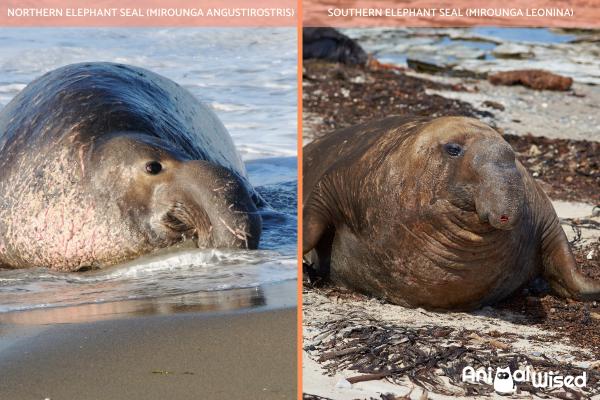
3. Tribe Lobodontini (Antarctic Seals)
The Lobodontini, or Antarctic seals, are the most cold-adapted of all pinnipeds, thriving in the harsh conditions of the Southern Ocean and Antarctic waters. Each species in this tribe has evolved specialized feeding strategies, reflected in their unique tooth structures and hunting behaviors. There are three species in this tribe.
Crabeater Seal (Lobodon carcinophagus):
This seal species inhabits Antarctica, although there are records of stray individuals in New Zealand, Australia, and South America. This species is more slender than other seals, can measure more than 2.5 meters (8.2 feet), and has dark gray fur that becomes lighter in summer.
This is another species that depends exclusively on oceanic ice blocks, as it spends most of its life on them. Additionally, more than 90% of its diet consists of krill because, due to the structure of its teeth, it cannot capture other prey, as they act as a filter.
It is a social species that lives in small groups, where both sexes take care of the young. It is also among the fastest seals, capable of diving to more than 400 meters (1,312 feet) in 11 minutes.
Leopard Seal (Hydrurga leptonyx):
The leopard seal is found in Antarctica and is also associated with oceanic ice platforms. It is large in size, with both females and males reaching more than three meters (9.8 feet) in length. Its fur is gray, becoming lighter on the ventral side, with spots on the neck and chest, which gives it its name. Its appearance is muscular, and its head resembles that of a large snake, with a very large mouth that reveals its long, sharp teeth.
It is a solitary and aggressive species, being the main predator of the emperor penguin in Antarctica. Additionally, its senses of sight and smell are highly developed, making it even more threatening. Its diet includes a variety of fish, squid, eggs of other birds, and penguins. In other words, it can catch anything that fits in its mouth.
Weddell Seal (Leptonychotes weddellii):
The Weddell seal is named after British explorer James Weddell and is one of the southernmost mammals in the world, with a circumpolar distribution around Antarctica.
These seals are known for their exceptional diving abilities, reaching depths of up to 600 meters (1,970 feet) and staying submerged for over an hour. They maintain breathing holes in the ice using their teeth, which often become worn down with age. Unlike many other Antarctic seals, Weddell seals produce complex underwater vocalizations that sound like chirps, trills, and other musical calls.
Ross Seal (Ommatophoca rossii):
The Ross seal is the smallest and least-known of the Antarctic seals, named after explorer James Clark Ross. They have a compact body with a short neck and a distinctive pattern of light stripes on the neck and chest against a dark background.
These seals have the most specialized diet among Antarctic seals, feeding primarily on squid, with some fish and krill. They have specialized throat structures that allow them to produce complex vocalizations both in air and underwater, described as siren-like calls. Ross seals are solitary animals that inhabit dense pack ice regions, which makes them difficult to study and partly explains why they remain one of the least understood seal species.
If you enjoyed learning about the diverse seal species, discover how they compare to their pinniped cousins in our informative guide to distinguishing these similar-looking marine mammals.
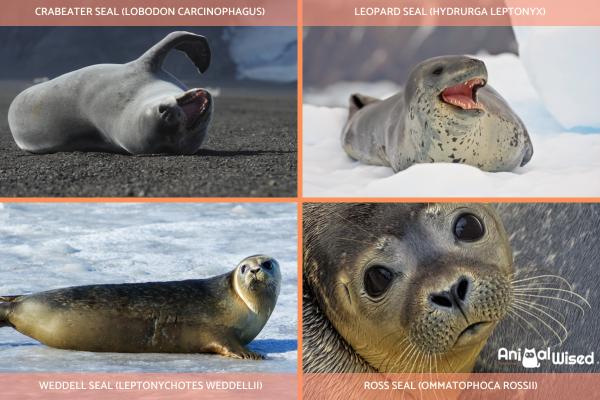
If you want to read similar articles to How Many Different Types of Seals Are There?, we recommend you visit our Facts about the animal kingdom category.
- Alaska Sea Grant. (2023). Pinnipeds: Seals, sea lions, and walrus. University of Alaska Fairbanks. https://seagrant.uaf.edu/marine-ed/mm/fieldguide/pinnipeds.html
- Animal Diversity Web. (2023). Phocidae (seals). University of Michigan Museum of Zoology. https://animaldiversity.org/accounts/Phocidae/
- Encyclopedia.com. (2022). True seals (Phocidae). Grzimek's Animal Life Encyclopedia. https://www.encyclopedia.com/environment/encyclopedias-almanacs-transcripts-and-maps/true-seals-phocidae
- MarineBio Conservation Society. (2023). Pinnipeds: Seals, sea lions & walruses. https://marinebio.org/species/pinnipeds/
- The Marine Mammal Center. (2023). Learn about pinnipeds. https://www.marinemammalcenter.org/education/marine-mammal-information/pinnipeds